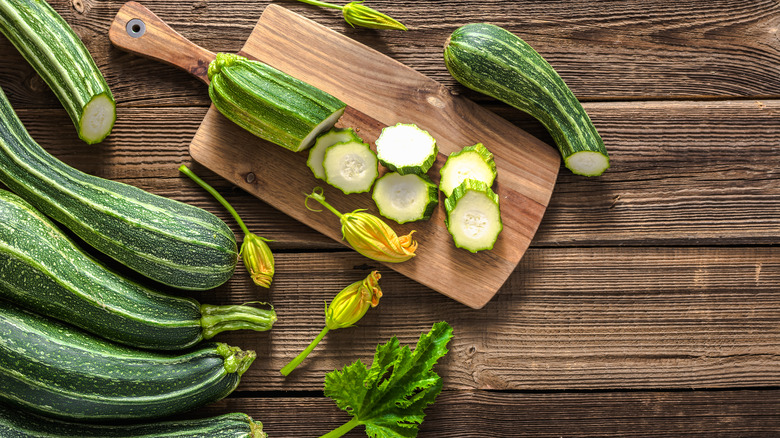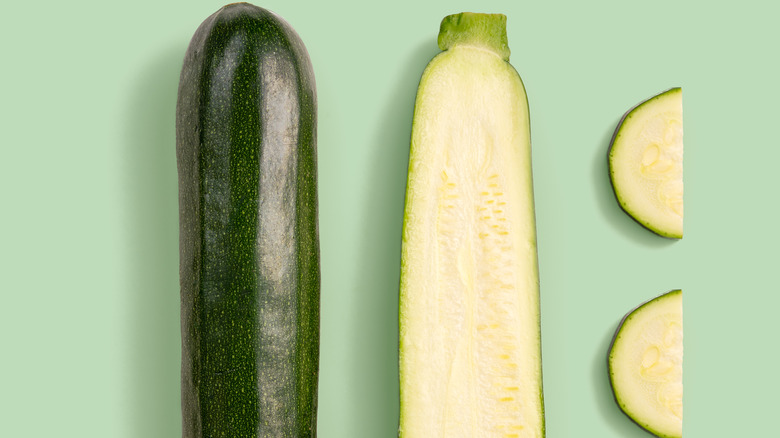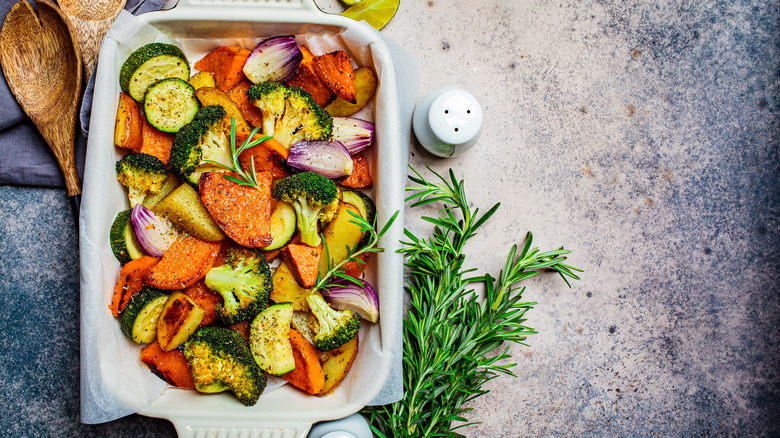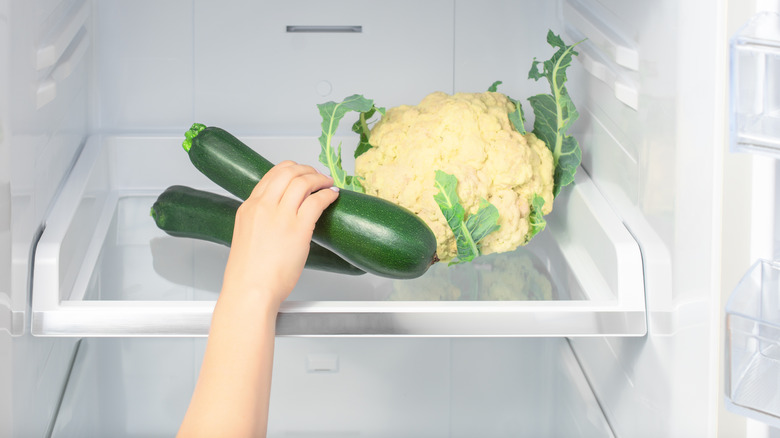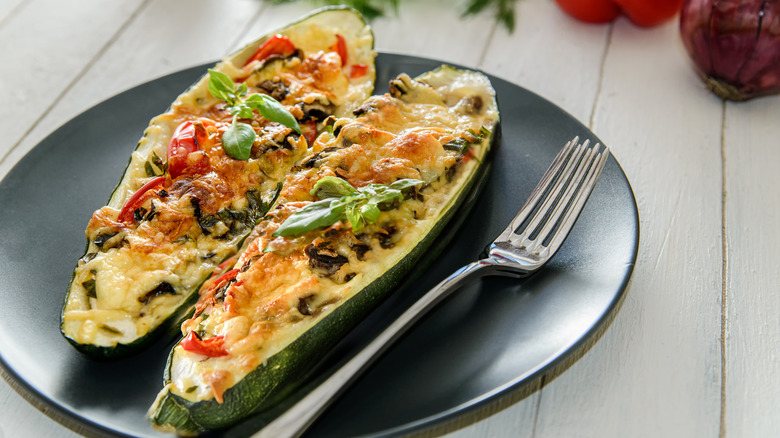What Is Zucchini And What Does It Taste Like?
Zucchini is a pretty popular and nutritious ingredient, especially in its peak summer season, from May to August (via The Spruce Eats). Whether you're roasting this plant at home or grilling in the great outdoors, zucchini is tasty, healthy, and easy to make. So what is it exactly?
Zucchini (also called courgette) is a type of squash that's generally firm and dark green in color — though some are golden, per Food Network. Its shape looks similar to a cucumber but with a stump-like stem at the end. And while most people consider zucchini to be a healthy summer vegetable, it's technically a fruit! My Recipes explains that's because zucchini contains seeds and also is the product of a flowering plant (the flowers of which are also edible). But when it comes to cooking, most people tend to view zucchini as a savory vegetable, which has more to do with taste than technicalities, since fruits are generally thought to be much sweeter than vegetables.
What does zucchini taste like?
Zucchini have firm, dark green outer skins which provide a slight bit of crunch. The inner flesh is much softer in texture and lighter in color, usually a pale yellow shade. The skin of the zucchini tastes rather grassy and earthy, and it's really the flesh of the fruit that contains most of the flavor. The inner part of the zucchini is slightly sweet with a relatively mild flavor and has a more prominent taste when cooked (via MasterClass). When zucchini is overripe, it can become very bitter.
Other very similar squash varieties such as yellow squash are closely related to zucchini in size, shape, texture, and taste (via The Kitchn), though some people think yellow squash is slightly sweeter, whereas zucchini has more of an earthy, "green" taste. Common zucchini cooking methods — including sautéeing in butter or oil, roasting in an oven, or charring over a grill — soften the zucchini's texture and elicit more of its natural flavor while also allowing it to mildly take on flavors of added seasonings and ingredients.
Nutritional information about zucchini
Aside from being a hearty, green vegetable that tastes great, zucchini is pretty nutritious and extremely versatile when cooking. A standard cup of zucchini is super low in calories as well as fat, sugar, and carbohydrate content (via Healthline). It's also very rich in nutrients like vitamin A, which supports vision and immune systems, and manganese, which "contributes to the metabolism of amino acids, cholesterol, glucose, and carbohydrates, and plays a role in bone formation, blood clotting, and reducing inflammation," as Medical News Today explains.
Zucchini also contains vitamin C, potassium, and vitamin B6. Plus, it's got small amounts of iron, calcium, and zinc, and is also fairly rich in antioxidants. Zucchini generally promotes healthy digestion when added to any meal or diet, probably due to its nutrient- and fiber-rich, green skin. It also helps that zucchini contains lots of water, which can help the stomach pass along food.
How to select and store zucchini
Luckily, zucchini and other variations of squash are pretty common and always in high demand, so they're usually easy to find. If you're heading to your local grocery store, you can find zucchini in the produce section. The Los Angeles Times recommends selecting larger, gray zucchini to use in soups while opting for the thinner, smaller zucchini when you're making a dish that calls for a rich flavor. The sweet spot is a zucchini size of six to eight inches. Generally speaking, two zucchini will go a long way when cooking, feeding two to four people, depending on how you prepare them (via Jessica Gavin).
Take a good look at your zucchini when selecting. You'll want to avoid any with large blemishes, brown spots, wrinkles, or those that look a little slimy. Zucchini that have a bit of stem or even small bristles are generally fresher (via The Kitchn).
Then, keep them in your refrigerator crisper drawer. The Kitchn says to avoid plastic bags, as these can turn your fruit slimy. Zucchini will typically last in the fridge (unwashed and uncut) for one to two weeks, though you might see wrinkles start to form at the ends over time.
How to prepare zucchini
It's also quite easy to add zucchini to your diet because of its versatility as a kitchen ingredient. As mentioned above, there are many different ways to cook zucchini, but even the method of preparation can vary, too. You may have heard of the ever-popular "zoodles," which is a fun name for zucchini noodles, or the long, spirally strings of zucchini that can be used in place of traditional grain noodles. Slicing into medallions and sautéeing or roasting are certainly popular methods, as is finely chopping or slicing and incorporating into savory baked goods like zucchini pancakes or zucchini bread.
These baked parmesan zucchini spears from Damn Delicious give us some real zucchini-fries-meet-elote vibes, and you've likely seen the fun and delicious, stuffed zucchini boats like those from Taste of Home. These are great for incorporating other ingredients like beef or your preferred protein, other veggies like mushrooms, or a savory, cheesy topping!
As for those zucchini blossoms mentioned earlier: They are light and super tasty when fried just right. Bon Appétit has a recipe that only requires six ingredients and will make for a fantastic summer snack. No matter how you decide to cook it, zucchini is a delicious, healthy treat and now that the season is upon us, it's the perfect time to head to your local farmer's market or grocery store and pick some up.
